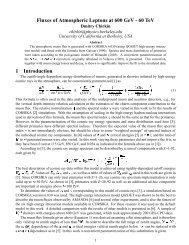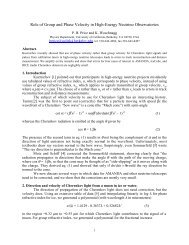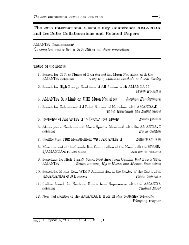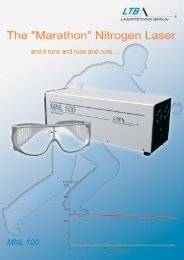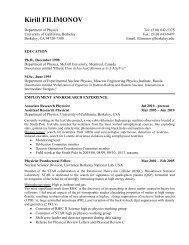Link to Fulltext
Link to Fulltext
Link to Fulltext
You also want an ePaper? Increase the reach of your titles
YUMPU automatically turns print PDFs into web optimized ePapers that Google loves.
369 m<br />
SPASE II<br />
AMANDA<br />
882 m<br />
Ice Runway<br />
840 m<br />
Geographic<br />
South Pole<br />
South Pole Dome<br />
Parallel Greenwich Meridian<br />
SPASE I<br />
Figure 11: Relative locations of AMANDA and the two sites of SPASE<br />
the melted ice can be recycled and heated up with boilers at the surface. The drill is constituted<br />
by a hose the length of a hole, with a drill head eight meters long attached <strong>to</strong> it, equipped with<br />
various instruments moni<strong>to</strong>ring its direction, the water flow and the diameter of the hole. This<br />
information is logged constantly and used later <strong>to</strong> reconstruct the profile of each hole and <strong>to</strong><br />
calibrate the position of the array. The drill head ends with a nozzle through which ¡ C hot<br />
water is pumped at a rate of 150 liter/minute, melting and scraping off bits of ice with its turbulent<br />
flow. The power requirement for drilling this way with a speed of 1 cm/s is 1.9 MW.<br />
It takes about three and a half days <strong>to</strong> drill a hole, depending on weather conditions, mechanical<br />
problems and sporadic re-freezing of portions of the hole which makes reaming necessary<br />
(i.e. taking the drill up <strong>to</strong> increase the hole diameter). Preparations are time consuming in the<br />
beginning of the season and include the unpacking of new <strong>to</strong>ols flown in that year, digging up of<br />
old equipment from previous campaigns, setting up of several boilers used <strong>to</strong> heat up the water<br />
flow from and in<strong>to</strong> the hole and many other tasks. Some time is also allocated at the end of the<br />
season for the tearing down of temporary installations and packing down most of the equipment<br />
<strong>to</strong> be either s<strong>to</strong>red at the South Pole or flown back home.<br />
The deployment of a new string proceeds immediately after the drilling of each hole, and<br />
must be completed within a time limit set by the re-freezing time of the hole which is 35-40<br />
hours. After the drill has been removed, the main cable containing the HV and service cables<br />
is lowered in<strong>to</strong> the hole. An optical module is connected <strong>to</strong> a cable breakout every 20 meters<br />
and a nylon ball with its optical fiber is attached below it. The OMs are connected one <strong>to</strong> the<br />
other with sections of steel cable and when all 20 modules are installed, the last module is attached<br />
<strong>to</strong> the main cable with a cable s<strong>to</strong>p. The <strong>to</strong>tal mass load on it is large but the <strong>to</strong>tal weight<br />
it must support is reduced by the buoyancy of the OMs. The main cable and the optical fibers<br />
are rolled up on winch operated reels and released very slowly in the beginning, with frequent<br />
24





